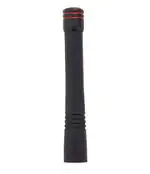ANT-433-CW-HD
Data Sheet
by
Product Description
This reduced-height ¼-wave antenna is ready for
years of use thanks to a flexible internal helical that
is over-molded with a heavy-duty protective jacket.
It’s an excellent choice for outdoor applications or
for use in adverse environments where the antenna
must resist shock, harsh weather and tampering.
HD Series antennas attach via standard SMA or
FCC Part 15 compliant RP-SMA connector.
12.3 mm
(0.48")
13.5 mm
(0.53")
10.5 mm
(0.41")
Features
88.0 mm
(3.46")
•
•
•
•
•
•
•
•
•
Reduced-height helical whip
Excellent performance
Omni-directional pattern
Very low VSWR
Heavy-duty construction
Damage-resistant
Fully weatherized
Flexible main shaft
Standard SMA or Part 15 compliant RP-SMA
connector
• Use with plastic* or metal enclosures
45.0 mm
(1.77”)
6.0 mm
0.24"
(0.53")
13.5 mm
* Requires proximity ground plane
Electrical Specifications
Center Frequency:
Recom. Freq. Range:
Wavelength:
VSWR:
Peak Gain:
Impedance:
Connection:
Oper. Temp. Range:
End View
433MHz
420–445MHz
¼-wave
≤ 2.0 typical at center
0.7dBi
50-ohms
RP-SMA or SMA
–30°C to +70°C
6.4 mm
(0.25”)
Electrical specifications and plots measured on a 10.16 cm x
10.16 cm (4.00" x 4.00") reference ground plane
Ordering Information
ANT-433-CW-HD
ANT-433-CW-HD-SMA
–1–
Revised 5/16/14
�Counterpoise
Quarter-wave or monopole antennas require an associated ground plane
counterpoise for proper operation. The size and location of the ground
plane relative to the antenna will affect the overall performance of the
antenna in the final design. When used in conjunction with a ground
plane smaller than that used to tune the antenna, the center frequency
typically will shift higher in frequency and the bandwidth will decrease.
The proximity of other circuit elements and packaging near the antenna
will also affect the final performance. For further discussion and guidance
on the importance of the ground plane counterpoise, please refer to Linx
Application Note AN-00501: Understanding Antenna Specifications and
Operation.
VSWR Graph
VSWR
Reflected Power
1.489
3:1
25%
2:1
11%
1:1
358MHz
0%
508MHz
433MHz
What is VSWR?
The Voltage Standing Wave Ratio (VSWR) is a measurement of how well
an antenna is matched to a source impedance, typically 50-ohms. It is
calculated by measuring the voltage wave that is headed toward the load
versus the voltage wave that is reflected back from the load. A perfect
match will have a VSWR of 1:1. The higher the first number, the worse the
match, and the more inefficient the system. Since a perfect match cannot
ever be obtained, some benchmark for performance needs to be set. In
the case of antenna VSWR, this is usually 2:1. At this point, 88.9% of the
energy sent to the antenna by the transmitter is radiated into free space
and 11.1% is either reflected back into the source or lost as heat on
the structure of the antenna. In the other direction, 88.9% of the energy
recovered by the antenna is transferred into the receiver. As a side note,
since the “:1” is always implied, many data sheets will remove it and just
display the first number.
How to Read a VSWR Graph
VSWR is usually displayed graphically versus frequency. The lowest point
on the graph is the antenna’s operational center frequency. In most cases,
this will be different than the designed center frequency due to fabrication
tolerances. The VSWR at that point denotes how close to 50-ohms the
antenna gets. Linx specifies the recommended bandwidth as the range
where the typical antenna VSWR is less than 2:1.
159 Ort Lane, Merlin, OR, US 97532
Phone: +1 541 471 6256
Fax: +1 541 471 6251
www.linxtechnologies.com
–2–
Data Sheet ANT-433-CW-HD
by
�
很抱歉,暂时无法提供与“ANT-433-CW-HD”相匹配的价格&库存,您可以联系我们找货
免费人工找货